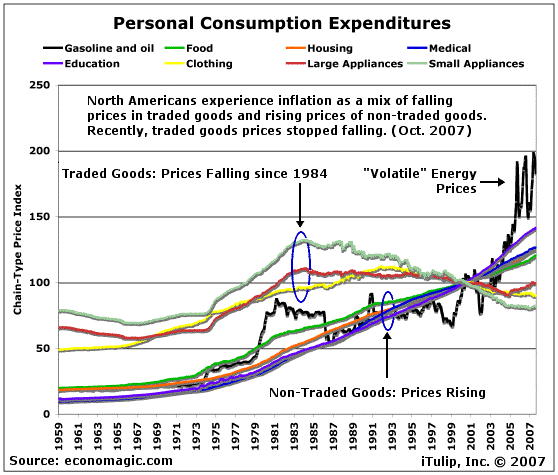The Cleveland Fed has another take on the Great Inflation Debate. We've seen elsewhere a distinction between what you need (e.g. food and gas, inflation expected) and what you want or what you borrow to purchase (e.g. real estate and cars, inflation less obvious.)
Now the Cleveland Fed distinguishes between volatile priced items (they call these "flexible") and stable priced items (they call these "sticky".) Flexible items include gas at the pump and fresh fruit at the grocery. Sticky items include rent and garbage collection.
They have some persuasive data and analysis, and some interesting results. From their synopsis:
You can find this Commentary at Are Some Prices in the CPI More Forward Looking Than Others? We Think So.
In short, the "sticky" items are (a) a good predictor of CPI, and (b) show continued "disinflation" (inflation down to 1.8 per-cent as of March 2010.)
Note that this commentary was published in May 2010.
(A tip of the hat to "Guest author" in a post at Barry Ritholtz's site.)
Now the Cleveland Fed distinguishes between volatile priced items (they call these "flexible") and stable priced items (they call these "sticky".) Flexible items include gas at the pump and fresh fruit at the grocery. Sticky items include rent and garbage collection.
They have some persuasive data and analysis, and some interesting results. From their synopsis:
Some of the items that make up the Consumer Price Index change prices frequently, while others are slow to change. We explore whether these two sets of prices—sticky and flexible—provide insight on different aspects of the inflation process. We find that sticky prices appear to incorporate expectations about future inflation to a greater degree than prices that change on a frequent basis, while flexible prices respond more powerfully to economic conditions—economic slack. Importantly, our sticky-price measure seems to contain a component of inflation expectations, and that component may be useful when trying to gauge where inflation is heading.
In short, the "sticky" items are (a) a good predictor of CPI, and (b) show continued "disinflation" (inflation down to 1.8 per-cent as of March 2010.)
Note that this commentary was published in May 2010.
(A tip of the hat to "Guest author" in a post at Barry Ritholtz's site.)

 ) than rent or garbage collection fees.
) than rent or garbage collection fees.
Comment